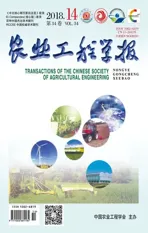不同结构滴灌双向流道灌水器抗堵性能对比试验
2018-08-10王新端宋立勋李嘉露吴山山
王新端,白 丹,宋立勋,郭 霖,李嘉露,吴山山
不同结构滴灌双向流道灌水器抗堵性能对比试验
王新端1,白 丹1※,宋立勋2,郭 霖1,李嘉露1,吴山山1
(1. 西安理工大学水利水电学院,西安 710048;2. 西安工程大学理学院,西安 710048)
该文开展滴灌双向流道抗堵性能研究,以提高灌水器对含沙率较高的地表水源的适应性。试验浑水含沙率为 30 g/L,经20次浑水试验,设置3种结构参数不同的双向流道灌水器(1#,2#,3#),并对比迷宫式流道灌水器的水力性能和抗堵性能。结果表明:1#、2#、3#双向流道浑水流量分别为清水流量的77.44%,83.35%,85.43%,而迷宫式流道在12次试验后完全堵塞。双向流道灌水器与迷宫式流道灌水器的水力性能及抗堵性能差异显著,且双向流道的水力性能及抗堵性能均优于迷宫式流道;双向流道水力性能越好,抗堵性能越差;流道形式及结构参数是影响灌水器水力性能及抗堵性能的重要因素。试验结束后,观测流道泥沙沉积情况,发现泥沙沉积程度由前段(进口)到后段(出口)逐渐减少;采用电子显微镜分别获取流道前段、中段和后段沉积泥沙样品扫描图像,利用Image Pro Plus 6.0软件分析沉积泥沙样品的粒径组成,发现沿流道方向,粒径>0.03 mm的泥沙颗粒质量分数逐渐减小,粒径<0.005 mm的泥沙颗粒质量分数呈先减小后增加的趋势;流道沉积泥沙中粒径<0.03 mm的颗粒质量分数占92.23%~97.89%,此粒径范围的泥沙颗粒更易在双向流道内沉积,引起堵塞。
泥沙;水力性能;流量;滴灌;双向流道;抗堵性能
0 引 言
中国干旱半干旱地区灌溉用水日趋紧张,采用含沙率较高的地表水源作为滴灌水源,成为缓解这一问题的有效途径之一[1],但面临的最大问题就是灌水器堵塞问题,因此如何提高灌水器抗堵性能是近年来的研究热点问题[2-4],如一些学者在研究利用黄河水滴灌中,重点也是如何提高灌水器的抗堵性能[5-6]。
解决灌水器堵塞问题的措施可分为2大类[7-8]:1)源头措施,即在滴灌工程首部,通过沉淀、过滤等措施,减少水中泥沙含量;2)终端措施,即提高灌水器的抗堵性能。滴灌通常采用120目网式过滤器,其网眼直径为0.125 mm,浑水经过过滤器,仍然有部分细小颗粒泥沙进入灌水器流道,在流道内沉积、固结导致灌水器堵塞[9-12]。目前提高滴灌灌水器抗堵性能的方法有:分析流道结构参数对流道内悬浮颗粒分布的影响[13],以选择合适的流道结构参数;面向水力性能和抗堵性能的多目标流道结构参数优化方法[14];消除灌水器流道内漩涡和低流速区的主航道设计[15];以流道内含沙量较低的等值线作为流道边界的流道优化[16];充分发展漩涡,增强流道“自清洗”能力等方法[17]。这些方法的目的都是通过选择合适的流道结构参数,优化流道边界,保证流道具有良好的流态,提高水流对泥沙颗粒的输运能力。
目前迷宫式流道抗堵性能试验中,灌水器堵塞程度一般用浑水流量相对于清水流量的变化量来评价,试验浑水含沙率一般为0.5、1.0、1.5、2、10 g/L[18],分析了灌水器堵塞与泥沙粒径、含沙率的相关关系,及引起灌水器堵塞的泥沙颗粒敏感粒径和临界含沙率,进而可为滴灌水质选择及灌水器结构改进提供依据[19-20]。利用电子显微镜扫描流道沉积泥沙的结构,可分析灌水器堵塞的诱发机制[21]。电镜扫描观测了沉积泥沙的结构,在此基础上可以对沉积泥沙的颗粒组成以及沉积泥沙沿流道方向的粒径变化进一步研究,分析其对灌水器抗堵性能的影响。
开发新的灌水器流道形式,依靠流道自身结构提高其性能,是灌水器发展的新思路[22]。双向流道的结构不同于迷宫式流道,流道中形成的正、反2股对冲水流强烈混掺,提高了流道消能效果,水力性能较好[23-25]。但其抗堵性能,尤其在含沙率较高条件下的抗堵性能如何,是有待研究的问题。
基于以上认识,配置含沙率较高的浑水水样,进行滴灌试验,对比观测泥沙沉积对双向流道和迷宫式流道流量变化的影响,观测双向流道泥沙沉积部位,同时分析水流运动对泥沙沉积的影响;采用电子显微镜扫描沉积泥沙的结构,利用粒径分析软件计算沉积泥沙沿流道方向的粒径分布,分析泥沙粒径变化对泥沙沉积的影响,明确流道内泥沙颗粒易沉积的粒径范围,为提高双向流道抗堵性能提供科学依据。
1 材料与方法
1.1 试验材料与装置
研究表明,滴灌灌水器水力性能与抗堵性能相互影响[18-20],为了研究滴灌双向流道灌水器的抗堵性能,并使研究结果具有一定代表性,参考文献[25]双向流道灌水器水力性能研究结果,在灌水器流态指数变化范围(0.424 7~0.462 5)内,选取流态指数最小值(0.424 7)、平均值(0.446 7)及最大值(0.462 5)对应的灌水器流道结构参数方案(共计3种结构)作为研究对象,开展浑水试验,研究其抗堵性能。同时,为了与迷宫式流道的抗堵性能进行对比,选用了直径为16 mm的内镶贴片式滴灌管,其内部流道为迷宫式,流道宽1 mm,深0.8 mm,长度80 mm,流道单元数20个。
双向流道结构如图1所示,相邻的2个分水装置和挡水装置组成1个流道单元;为试验制作的3种双向流道的深度、单元数及流道单元间距(单元间距见图2)相同,均为0.9 mm、20个和1.2 mm。流道其他结构参数及取值见图2和表1。试验流道由底板和隔水盖板2部分组成,底板选用PVC材料,与迷宫流道材料接近;隔水盖板用有机玻璃材料。采用高精密雕刻机(制造厂商:北京精雕科技有限公司;型号:EM-G32S-X32)切割成型,制造精度0.01 mm。每种结构参数组合方案的流道制作5个试件。

1. 进水口 2. 分水装置 3. 挡水装置 4. 流道边壁 5. 出水口

注:S为分水装置与边壁的间距,mm;T为挡水装置齿尖与分水装置的间距,mm;W为挡水装置与边壁的间距,mm;Z为挡水装置与分水装置最大过水通道宽度,mm;D为挡水装置底柱高,mm;L为流道单元间距,mm,下同。

表1 灌水器结构参数取值及水力性能
配制浑水的试验用土经自然风干、研磨后,过120目筛网(孔径为0.125 mm),接近工程实际中网式过滤器目数。参照有关高含沙水源的含沙率[26],本试验浑水含沙率设定为30 g/L。
试验测试装置如图3所示,主要由水箱、浑水收集桶、搅拌器、精密压力表及水泵组成。水箱体积为150 L,上方装有转速为0~700 r/min搅拌器,用于搅拌箱体水流保证水沙混合均匀。水泵额定扬程15 m,流量0.72 m3/h。压力表量程0.16 MPa,精度0.25 级。浑水收集桶容积为150 L。灌水器流量测量部分并联安装了5根支管,每根支管上安装1个灌水器试件,共计5个试件(5个试件的结构参数均相同)。浑水水样流经灌水器试件后直接流入浑水收集桶,不再循环使用。试验装置见图3。
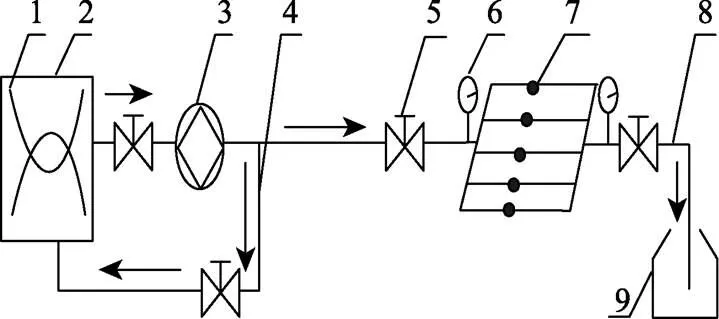
1. 搅拌器 2. 水箱 3. 水泵 4. 回水支管 5.阀门 6.压力表 7.灌水器 8. 尾管 9. 浑水收集桶
1. Agitator 2. Water tank 3. Water pump 4. Backwater branch pipe 5. Valve 6. Pressure gauge 7. Emitters 8. Tail pipe 9. Gathering barrel for muddy water
注:图中箭头表示水流运动方向。
Note: Arrows in figure indicate the direction of the flow.
图3 浑水试验测试装置示意图
Fig.3 Schematic diagram of muddy water testing apparatus
1.2 试验方法
试验分清水试验和浑水试验2部分。
1.2.1 清水试验及水力性能评价方法
清水试验参照GB/T17187-2009《农业灌溉设备滴头和滴灌管技术规范和试验方法》[27]的要求安排试验,在50~150 kPa进口压力下测试4种灌水器的流量,每次测试时间均持续5 min,取各试件流量的平均值作为其在每个压力点的流量值。
灌水器压力和流量关系为[28]:

对式(1)等式两边取自然对数得:

将清水试验中灌水器在不同进口压力下的流量值,代入式(2),通过回归计算即可得到流量系数及流态指数。
1.2.2 浑水试验及抗堵性能评价方法
浑水试验中灌水器的流量测试分4组进行(每组测试试验方法均相同),每组测试1种灌水器,共测试4种,其中3种为双向流道灌水器,另1种为迷宫式流道灌水器,灌水器测试时的进口压力均为50 kPa。采用周期性间歇灌水测试方法,每次灌水30 min,其中第25 min开始测量流量,流量测量5 min;每种灌水器并联连接5个试件,每个试件均由主管道供水,在相同试验条件下(进口压力及含沙率均相同)进行试验(相当于做了5次重复),将不同类型、相同结构参数的灌水器试件的实测流量取平均值,作为其在不同试验次数时的流量值,灌水间隔30 min;共进行20次浑水试验;每组试验测试结束后,将水箱浑水水样排出,同时更换浑水水样(事先已配制,各物理参数均相同)。

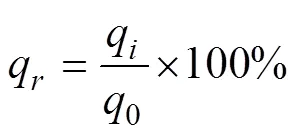
1.2.3 灌水器流道沉积泥沙粒径测量方法p
浑水试验后,对灌水器流道内的沉积泥沙取样,采用Quanta-450-FEG+X-MAX50电子显微镜(FEI、英国牛津)对所取得的泥沙样本扫描观测;将泥沙样本的扫描图片导入到粒径分析软件Image Pro Plus 6.0测量其粒径组成,测量的主要步骤如下:
1)对图片进行反相处理。电子显微镜扫描时,泥沙颗粒的亮度较高,图片显示为高亮;而颗粒间隙处亮度较低,图片显示为暗色。Image Pro Plus 6.0测量时,将扫描图片中泥沙颗粒调为暗色(文中测量时调为黑色),将颗粒间隙处调为亮色(文中测量时调为白色),使得泥沙颗粒的轮廓清晰,可提高测量准确度。
2)设置测量的指标。Image Pro Plus 6.0可测量泥沙颗粒的面积、周长等信息,文中选择测量泥沙颗粒的面积,然后根据面积反求粒径。
3)利用软件的捕捉功能,对图片中对泥沙颗粒的轮廓进行捕捉,然后对照原图,对捕捉到的轮廓进行修正(包括轮廓的分割及合并等)。
4)将测量的数据导入到Excel中,根据电子显微镜的放大倍数,对测量数据进行计算及相关统计,最后得到泥沙颗粒的不同粒径组成。
2 结果与分析
2.1 清水试验结果
2.1.1 灌水器水力性能
根据清水试验结果及灌水器水力性能计算方法,计算可得灌水器的水力性能,4种灌水器的流量系数和流态指数如表1所示。
2.1.2 灌水器水力性能差异的显著性分析
对灌水器的平均流态指数做单因素方差分析,用LSD法进行多重比较[30],分析4种灌水器水力性能差异,结果见表2。由表2可知,4种灌水器水力性能差异显著,说明灌水器内部流道的结构形式及结构参数对灌水器的水力性能有显著的影响;双向流道水力性能整体上优于迷宫式流道;3种双向流道中,1#水力性能最优,2#其次,3#最差。

表2 灌水器水力性能显著性分析
注:同一列字母不同者表示差异显著(<0.05)。下同。
Note: Values in the same column with different label letter differ significantly (<0.05). Same as below.
2.2 浑水试验结果
2.2.1 灌水器流量变化
将20次浑水试验的结果绘制成灌水次数-相对流量曲线,见图4。

图4 灌水器相对流量变化过程
从图4可以看出,4个灌水器流量均呈现下降趋势,表明灌水器都发生不同程度的堵塞。流量下降过程中均存在波动,说明灌水器堵塞存在堵塞-冲洗-再堵塞的反复过程。20次浑水试验后,1#、2#和3#双向流道的相对流量分别为77.44%,83.35%,85.43%,均在相同进口压力下清水流量的75%以上,即未到达堵塞标准。迷宫式流道相对流量降幅较大,在灌水第12次完全堵塞。
2.2.2 灌水器抗堵性能差异的显著性分析
浑水试验结束后,对灌水器的相对流量平均值做单因素方差分析及LSD多重比较,分析4种灌水器抗堵性能差异,结果见表3。由表3可知,4种灌水器的抗堵性能差异显著,说明灌水器流道的结构形式及结构参数是影响其抗堵性能的重要因素;双向流道抗堵性能整体上优于迷宫式流道;3种双向流道中,3#抗堵性能最优,2#其次,1#最差。

表3 灌水器抗堵性能显著性分析
综上,双向流道的水力性能与抗堵性能均优于迷宫式流道,主要是因为两者的工作机理不同,即迷宫式流道主要依靠流道边界几何形状的突变使水流维持紊流状态,而双向流道主要利用流道中形成的正、反2股水流强烈对冲、混掺,不仅提高了流道消能效果[25],还有利于泥沙颗粒充分扰动并离底悬浮,提高水流挟沙能力,增强双向流道的抗堵塞能力。另外,3种双向流道中,1#水力性能最优,2#其次,3#最差;而抗堵性能1#最差,2#其次,3#最优,因此双向流道水力性能越好,抗堵性能越差,这一点与迷宫式流道是相同的[31]。说明灌水器水力性能和抗堵塞能力是一对相互制约的因素,灌水器设计不能单纯地以提高水力性能为目标,要在保持一定水力性能的基础上提高抗堵塞能力,以保证灌水器的整体性能。
2.3 双向流道泥沙沉积部位及成因
研究表明,同种类型、不同结构的灌水器,堵塞的位置及堵塞成因具有一定的相似性[20]。因此,以堵塞较为严重的1#双向流道为代表,观测泥沙沉积情况并分析成因,其泥沙沉积情况见图5。

图5 双向流道(1#)泥沙沉积情况
由图5可知,双向流道进口、分水和挡水装置壁面是泥沙沉积的主要部位,出口处沉积较少;流道前段泥沙沉积严重,中段次之,后段沉积较少。
流道进口处:泥沙颗粒在表面电荷的作用下彼此黏结,与流道壁面的粘附应力相互作用,沉积于壁面。
流道内部:1)水流在分水装置的作用下分流[32],水体结构变化,水流重新分配能量以适应新流动,增加了泥沙颗粒碰撞概率,易形成较大团聚体在分水装置迎水壁面黏结、沉积。2)在挡水装置迎水面底部水流流向急转,由于离心惯性力的作用,外侧水流与主流区水流分离,产生漩涡,而旋涡的中心水流流速很低,困于漩涡中心的泥沙颗粒更容易彼此黏结增大,最终沉积于流道。3)在挡水装置背水面,一方面,流道截面突扩,水流压力降低,在突扩处不能立即贴附于壁面,形成漩涡,造成泥沙沉积;另一方面,流道截面突扩,水流流速降低,冲刷减弱,也增加了泥沙沉积风险。4)在流道混掺处,正向、反向2股水流对冲混掺,水流紊动较强,紊动的增加有利于泥沙颗粒充分扰动并离底悬浮[33-34],并增加流体的剪切速率,促使颗粒聚团破碎[35]。同时,混掺处过水断面收缩,流速增大,冲洗强度增大,增加了泥沙颗粒流出的机会,因此混掺区泥沙颗粒不易沉积。
流道出口处:水流流速较缓,泥沙颗粒间碰撞几率较低,不易彼此黏结形成较大颗粒,沉积概率降低。
3 双向流道沉积泥沙粒径分布规律及成因分析
利用电子显微镜,对过筛后的原状泥沙和流道内沉积泥沙进行扫描观测,并利用粒径分析软件Image Pro Plus 6.0分析泥沙粒径组成,其中沉积泥沙是从1#灌水器流道前段、中段和后段分别取样,电镜扫描图见图6,泥沙颗粒组成见表4。
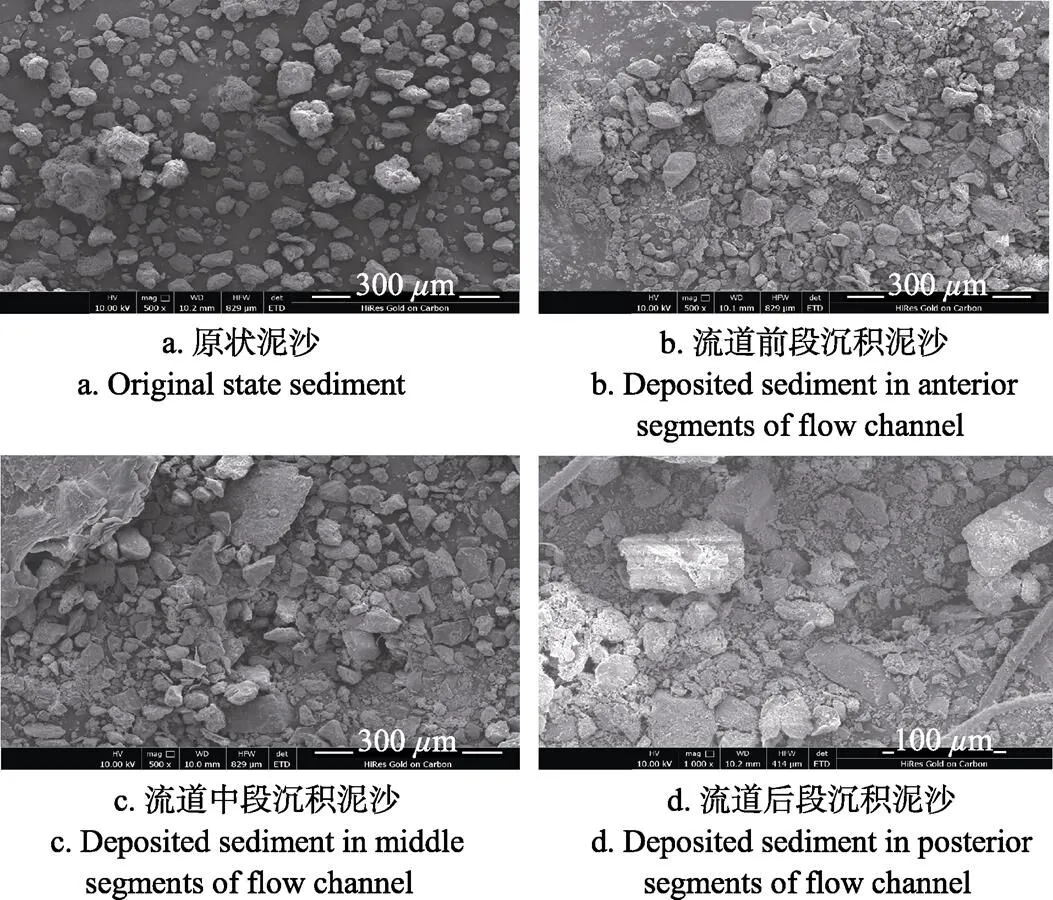
图6 原状和沉积泥沙电子显微镜扫描图片
从图6可以看出,原状泥沙颗粒大小分明,颗粒之间分布松散。流道前段沉积泥沙的结构主要为小颗粒填充于大颗粒之间形成的团聚体,结合表4,在该段沉积泥沙中,粒径>0.03 mm的颗粒质量分数为7.77%,粒径<0.005 mm的黏粒质量分数为65.98%;由于泥沙粒径>0.03 mm时絮凝作用不明显[36],因此利于大量小颗粒隐藏于大颗粒空隙之间,使得小颗粒受到的水流的拖曳力与上举力减小,同时在小颗粒的黏附与大颗粒的基础骨架作用下,颗粒间的力链稳定,易形成结构紧实的团聚体[37-38]。流道中段沉积泥沙结构与流道前段类似,粒径>0.03 mm的颗粒质量分数为5.13%,粒径<0.005 mm的黏粒质量分数为56.31%,相对前段均有所减小,形成的团聚体紧实程度降低,容易在水流剪切作用下被破坏,因此该段泥沙沉积程度相对前段降低。流道后段沉积泥沙大部分为小颗粒形成的絮团结构,粒径>0.03 mm的颗粒质量分数减小到2.11%,粒径<0.005 mm的黏粒质量分数增大到69.76%,泥沙颗粒粒径愈小,其比表面积愈大,颗粒絮凝作用愈强,但该段大粒径颗粒质量分数较小,絮团缺少稳定的基础骨架结构,组成絮团的颗粒间的联结力不强,絮团不足以克服流体的高剪切速率[39],容易破碎,进而随水流运动流出流道,这成为流道该段泥沙沉积程度低于前段和中段的重要原因。
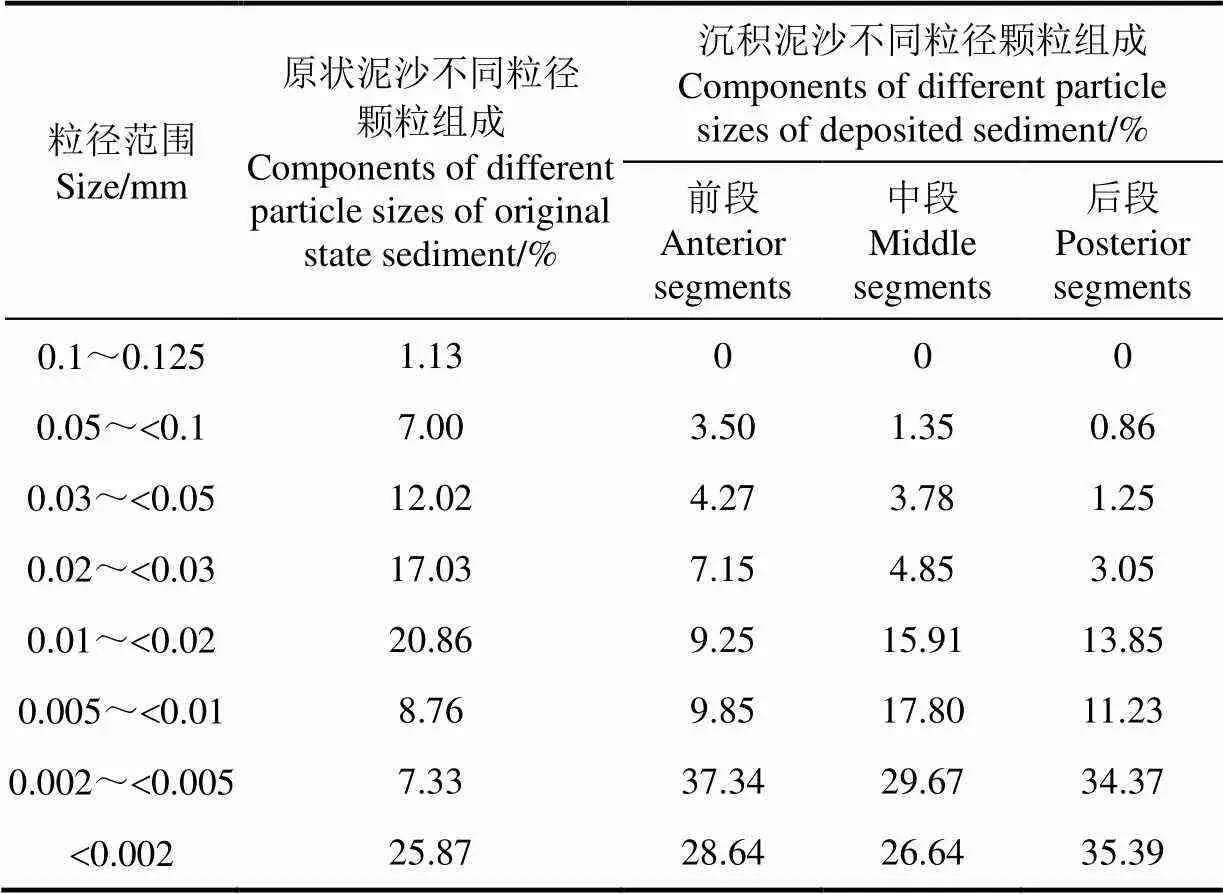
表4 原状和沉积泥沙颗粒组成
从表4也可以看出,流道沉积泥沙中粒径>0.03 mm的颗粒质量分数较小,在2.11%~7.77%之间;而粒径<0.03 mm的颗粒量分数较大,在92.23%~97.89%之间,因此对于双向流道来说,粒径<0.03 mm细小泥沙颗粒更易引起流道堵塞。
流道中沉积泥沙粒径呈现为大颗粒的质量分数逐渐减小,小颗粒的质量分数先减小后增加的分布趋势。这是因为水流挟沙时,泥沙颗粒在水流中的悬浮是由水流的紊动能量来支持的。在流道前段,水流紊动作用较强,高剪切速率不利于絮凝产生[40],使得大量小颗粒以分散形式填充于大颗粒之间,形成结构紧实的团聚体沉积于流道,导致流道前段大颗粒和小颗粒质量分数都很高。另一部分小颗粒随水流运动,在流道消能作用下,流道后段水流紊动能量降低,水流的剪切作用有所减弱,絮凝作用相对增强,由于泥沙颗粒的重力与颗粒的体积成正比,因此所形成的絮团容易在重力作用下沉淀堆积,所以流道后段沉积泥沙中小颗粒质量分数有所增加。流道中段颗粒分布情况介于前段和后段之间。
4 结论与建议
1)在较高的含沙率(30 g/L)条件下,双向流道灌水器仍具有较好的抗堵塞能力,且抗堵性能优于作为对比的迷宫式流道灌水器。双向流道灌水器与迷宫式流道灌水器的抗堵性能差异显著,主要是因为两者流道结构形式及工作机理不同,双向流道中形成的正、反2股对冲水流强烈混掺,提高了水流的挟沙能力,增强了灌水器的抗堵塞能力。
2)结构参数不同的双向流道灌水器,水力性能及抗堵性能差异显著;水力性能越好的流道,抗堵性能越差,与迷宫式流道的研究结果相同;双向流道灌水器流道结构参数对其整体性能有显著影响。
3)双向流道灌水器堵塞位置主要发生在流道进口、分水和挡水装置附近,流道前段泥沙沉积严重,中段次之,后段较少。漩涡的存在是泥沙沉积发生的主要诱因;流道混掺部位水流紊动较强、剪切速率大,泥沙不易沉积。
4)双向流道灌水器沿流道方向,沉积泥沙中粒径>0.03 mm的颗粒质量分数从7.77%减小到2.11%,粒径<0.005 mm的黏性颗粒质量分数先从65.98%减小到56.31%后增加到69.76%;沉积泥沙粒径的变化直接影响沉积泥沙结构,流道前段、中段沉积泥沙主要为结构紧实的团聚体,后段沉积泥沙主要为小颗粒形成的絮团结构。
5)双向流道沉积泥沙中粒径﹤0.03 mm的颗粒质量分数较高,此粒径范围的泥沙颗粒间的絮凝作用较强,当流道水流剪切速率较低时,易形成较大的絮团沉积于流道,从而引起灌水器堵塞发生。
文中从沉积泥沙的结构特点与粒径分布角度出发,分析双向流道灌水器泥沙沉积规律。灌水器流道结构参数直接影响流道内水流的流态,从而影响流道内泥沙的运动,因此,更多结构参数组合的灌水器抗堵性能测试及各结构参数对灌水器流道泥沙沉积的影响规律有待进一步研究。
[1] 齐学斌,樊向阳,王景雷,等. 井渠结合灌区水资源高效利用调控模式[J]. 水利学报,2004,35(10):119-124. Qi Xuebin, Fan Xiangyang, Wang Jinglei, et al. Optimal allocation of water resources in well-canal combined irrigated area for high efficient utilization of water[J]. Journal of Hydraulic Engineering, 2004, 35(10): 119-124. (in Chinese with English abstract)
[2] 仵峰,范永申,李辉,等. 地下滴灌灌水器堵塞研究[J]. 农业工程学报,2004,20(1):80-83. Wu Feng, Fan Yongshen, Li Hui, et al. Clogging of emitter in subsurface drip irrigation system[J]. Transactions of the Chinese Society of Agricultural Engineering (Transactions of the CSAE), 2004, 20(1): 80-83. (in Chinese with English abstract)
[3] Madramootoo C A, Morrison J. Advances and challenges with micro-irrigation[J]. Irrigation and Drainage, 2013, 62(3): 255-261.
[4] Zhang Lin, Wu Pute, Zhu Delan, et al. Effect of pulsating pressure on labyrinth emitter clogging[J]. Irrigation Science, 2017, 35(4): 1-8.
[5] 孙贯芳,于健,杜斌,等. 过滤后黄河水对滴灌系统的影响[J]. 排灌机械工程学报,2015,33(10):901-907. Sun Guanfang, Yu Jian, Du Bing, et al. Influence of the Yellow River water filtered on drip irrigation system[J]. Journal of Drainage and Irrigation Machinery Engineering (JDIME), 2015, 33(10): 901-907. (in Chinese with English abstract)
[6] 孙步功,龚俊,辛舟,等. 滴灌用黄河水泥沙分离试验研究[J]. 农业工程学报,2008,24(8):51-53. Sun Bugong, Gong Jun, Xin Zhou, et al. Experimental study on Yellow River’s silt separation for drip irrigation[J]. Transactions of the Chinese Society of Agricultural Engineering (Transactions of the CSAE), 2008, 24(8): 51-53. (in Chinese with English abstract)
[7] 仵峰,宰松梅,翟国亮,等. 高含沙水滴灌技术研究[J]. 节水灌溉,2008(12):57-60. Wu Feng, Zai Songmei, Zhai Guoliang, et al. Mitigation- clogging drip irrigation technology using high sediment water[J]. Water Saving Irrigation, 2008(12): 57-60. (in Chinese with English abstract)
[8] 于坤,郁松林,符小发,等. 防堵塞地下滴灌系统设计与性能试验分析[J]. 农业机械学报,2014,45(3):124-128. Yu Kun, Yu Songlin, Fu Xiaofa, et al. Design and performance experiment of anti-clogging of subsurface drip irrigation system[J]. Transactions of the Chinese Society for Agricultural Machinery, 2014, 45(3): 124-128. (in Chinese with English abstract)
[9] Pei Yiting, Li Yunkai, Liu Yaoze, et al. Eight emitters clogging characteristics and its suitability evaluation under on-site reclaimed water drip irrigation[J]. Irrigation Science, 2014, 32(2): 141-157.
[10] Bounoua S, Tomas S, Labille J, et al. Understanding physical clogging in drip irrigation: In situ, in-lab and numerical approaches[J]. Irrigation Science 2016, 34: 327-342.
[11] Oliveira F C, Lavanholi R, Camargo A P, et al. Influence of concentration and type of clay particles on dripper clogging[J]. Irrigation and Drainage Systems Engineering, 2017, 6(1): 184-188.
[12] 喻黎明,徐霞,杨启良,等. 滴灌灌水器迷宫流道结构对泥沙运动的影响[J]. 农业机械学报,2017,48(2):255-261. Yu Liming, Xu Xia, Yang Qiliang, et al. Influence of geometrical parameters of labyrinth passage of drip irrigation emitter on sand movement[J]. Transactions of the Chinese Society for Agricultural Machinery, 2017, 48(2): 255-261. (in Chinese with English abstract)
[13] 王文娥,王福军,牛文全,等. 滴头流道结构对悬浮颗粒分布影响的数值分析[J]. 农业工程学报,2009,25(5):1-6. Wang Wen’e, Wang Fujun, Niu Wenquan, et al. Numerical analysis of influence of emitter channel structure on suspended granule distribution[J]. Transactions of the Chinese Society of Agricultural Engineering (Transactions of the CSAE), 2009, 25(5): 1-6. (in Chinese with English abstract)
[14] Zhang Jun, Zhao Wanhua, Tang Yiping. Structural optimization of labyrinth-channel emitters based on hydraulic and anti-clogging performances [J]. Irrigation Science, 2006, 29: 351-357.
[15] 魏正英,赵万华,唐一平,等. 滴灌灌水器迷宫流道主航道抗堵设计方法研究[J]. 农业工程学报,2005,21(6):1-7. Wei Zhengying, Zhao Wanhua, Tang Yiping, et al. Anti-clogging design method for the labyrinth path of drip irrigation emitters[J]. Transactions of the Chinese Society of Agricultural Engineering (Transactions of the CSAE), 2005, 21(6): 1-7. (in Chinese with English abstract)
[16] 牛文全,吴普特,喻黎明. 基于含沙量等值线的迷宫流道结构抗堵塞设计与模拟[J]. 农业工程学报,2010,26(5):14-20. Niu Wenquan, Wu Pute, Yu Liming. Anti-clogging experimental investigation and optimized design of micro- channels of emitter based on isoclines of sand content[J]. Transactions of the Chinese Society of Agricultural Engineering (Transactions of the CSAE), 2010, 26(5): 14-20. (in Chinese with English abstract)
[17] Feng Ji, Li Yunkai, Wang Weinan, et al. Effect of optimization forms of flow path on emitter hydraulic and anti-clogging performance in drip irrigation system[J]. Irrigation Science, 2017, 36(2): 1-11.
[18] Niu Wenquan, Liu Lu, Chen Xue. Influence of fine particle size and concentration on the clogging of labyrinth emitters[J]. Irrigation Science, 2013, 31(4): 545-555.
[19] 吴泽广,张子卓,张珂萌,等. 泥沙粒径与含沙量对迷宫流道滴头堵塞的影响[J]. 农业工程学报,2014,30(7):99-108. Wu Zeguang, Zhang Zizhuo, Zhang Kemeng, et al. Influence of particle size and concentration of sediment on clogging of labyrinth channels emitters[J]. Transactions of the Chinese Society of Agricultural Engineering (Transactions of the CSAE), 2014, 30(7): 99-108. (in Chinese with English abstract)
[20] 刘璐,牛文全,Bob Zhou. 细小泥沙粒径对迷宫流道灌水器堵塞的影响[J]. 农业工程学报,2012,28(1):87-93. Liu Lu, Niu Wenquan, Bob Zhou. Influence of sediment particle size on clogging performance of labyrinth path emitters[J]. Transactions of the Chinese Society of Agricultural Engineering (Transactions of the CSAE), 2012, 28(1): 87-93. (in Chinese with English abstract)
[21] 穆乃君,张昕,李光永,等. 内镶片式齿型迷宫滴头抗堵塞试验研究[J]. 农业工程学报,2007,23(8):34-39. Mu Naijun, Zhang Xin, Li Guangyong, et al. Experimental study on anti-clogging performance of dental labyrinth flow passage of drip emitters[J]. Transactions of the Chinese Society of Agricultural Engineering (Transactions of the CSAE), 2007, 23(8): 34-39. (in Chinese with English abstract)
[22] Wei Qingsong, Shi Yusheng, Lu Gang, et al. Study of hydraulic performance of the eddy channel for drip emitters[J]. Irrigation and Drainage, 2006, 55(1): 61-72.
[23] 田济扬,白丹,任长江,等. 滴灌双向流流道灌水器水力特性分析[J]. 农业工程学报,2013,29(20):89-94. Tian Jiyang, Bai Dan, Ren Changjiang, et al. Analysis on hydraulic performance of bidirectional flow channel of drip irrigation emitter[J]. Transactions of the Chinese Society of Agricultural Engineering (Transactions of the CSAE), 2013, 29(20): 89-94. (in Chinese with English abstract)
[24] 田济扬,白丹,于福亮,等. 基于Fluent软件的滴灌双向流流道灌水器水力性能数值模拟[J]. 农业工程学报,2014,30(20):65-71. Tian Jiyang, Bai Dan, Yu Fuliang, et al. Numerical simulation of hydraulic performance on bidirectional flow channel of drip irrigation emitter using Fluent[J]. Transactions of the Chinese Society of Agricultural Engineering (Transactions of the CSAE), 2014, 30(20): 65-71. (in Chinese with English abstract)
[25] 郭霖,白丹,王新端,等. 双向对冲流滴灌灌水器水力性能与消能效果[J]. 农业工程学报,2016,32(17):77-82. Guo Lin, Bai Dan, Wang Xinduan, et al. Hydraulic performance and energy dissipation effect of two-ways mixed flow emitter in drip irrigation[J]. Transactions of the Chinese Society of Agricultural Engineering (Transactions of the CSAE), 2016, 32(17): 77-82. (in Chinese with English abstract)
[26] 周博,李云开,宋鹏,等. 引黄滴灌系统灌水器堵塞的动态变化特征及诱发机制研究[J]. 灌溉排水学报,2014,33(4/5):123-128. Zhou Bo, Li Yunkai, Song Peng, et al. Dynamics characteristics and inducing mechanism of emitter clogging in the drip irrigation system using Yellow River water[J]. Journal of Irrigation and Draingae, 2014, 33(4/5): 123-128. (in Chinese with English abstract)
[27] 农业灌溉设备滴头和滴灌管技术规范和试验方法:GB/T17187-2009[S]. 北京:中国标准出版社,2010.
[28] 姚振宪,何松林. 滴灌设备与滴灌系统规划设计[M]. 北京:中国农业出版社,1999.
[29] Microirrigation emitter-clogging procedure: Drafts of ISO/TC 23/SC 18/WG5[S].
[30] 李志西,杜双奎. 试验优化设计与统计分析[M]. 北京:科学出版社,2010.
[31] 苑伟静,魏正英,楚华丽,等. 分流式灌水器结构优化设计与试验[J]. 农业工程学报,2014,30(17):117-124. Yuan Weijing, Wei Zhengying, Chu Huali, et al. Optimal design and experiment for divided-flow emitter in drip irrigation[J]. Transactions of the Chinese Society of Agricultural Engineering (Transactions of the CSAE), 2014, 30(17): 117-124. (in Chinese with English abstract)
[32] 郭霖,白丹,王新端,等. 双向对冲流灌水器水力性能和消能机理模拟与验证[J]. 农业工程学报,2017,33(14):100-107. Guo Lin, Bai Dan, Wang Xinduan, et al. Numerical simulation and verification of hydraulic performance and energy dissipation mechanism of two-ways mixed flow emitter[J]. Transactions of the Chinese Society of Agricultural Engineering (Transactions of the CSAE), 2017, 33(14): 100-107. (in Chinese with English abstract)
[33] Li Yunkai, Yang Peiling, Xu Tingwu, et al. CFD and digital particle tracking to assess flow characteristics in the labyrinth flow path of a drip irrigation emitter[J]. Irrigation Science, 2008, 26(5): 427-438.
[34] 冯吉,孙昊苏,李云开. 滴灌灌水器内颗粒物运动特性的数字粒子图像测速[J]. 农业工程学报,2013,29(13):90-97. Feng Ji, Sun Haosu, Li Yunkai. Visualizing particles movement characteristics in drip irrigation emitters with digital particle image velocimetry[J]. Transactions of the Chinese Society of Agricultural Engineering (Transactions of the CSAE), 2013, 29(13): 90-97. (in Chinese with English abstract)
[35] 钱宁,万兆慧.泥沙运动力学[M]. 北京:科学出版社,1983.
[36] 张德茹,梁志勇. 不均匀细小颗粒泥沙粒径对絮凝的影响试验研究[J]. 水利水运科学研究,1994(1):11-17. Zhang Deru, Liang Zhiyong. Experiment study of effect of nonuniform fine sediment on flocculation[J]. Hydroscience and Engineering, 1994(1): 11-17. (in Chinese with English abstract)
[37] 柴朝晖,杨国录,王茜,等. 紊流对粘性细颗粒泥沙絮凝影响[J]. 水科学进展,2012,23(6):808-814. Chai Zhaohui, Yang Guolu, Wang Xi, et al. Effect of turbulent flow on flocculation of fine cohesive sediment[J]. Advances in Water Science, 2012, 23(6): 808-814. (in Chinese with English abstract)
[38] 柴朝晖,方红卫,姚仕明,等. 黏性泥沙絮凝-沉降-再悬浮运动过程数学模型研究[J]. 水利学报,2016,47(12):1540-1546. Chai Zhaohui, Fang Hongwei, Yao Shiming, et al. A model for the flocculation-settling-resuspension process of cohesive sediment[J]. Journal of Hydraulic Engineering, 2016, 47(12): 1540-1546. (in Chinese with English abstract)
[39] 张金凤,张庆河,乔光全. 水体紊动对黏性泥沙絮凝影响研究[J]. 水利学报,2013,44(1):67-72. Zhang Jinfeng, Zhang Qinhe, Qiao Guangquan. The effects of turbulence on flocculation of cohesive sediments[J]. Journal of Hydraulic Engineering, 2013, 44(1): 67-72. (in Chinese with English abstract)
[40] 朱中凡,赵明,杨铁笙. 水流剪切对细颗粒泥沙絮凝作用实验研究的综述[J]. 泥沙研究,2014(4):73-80. Zhu Zhongfan, Zhao Ming, Yang Tiesheng. Review on experimental research on effect of shear flow on flocculation of cohesive sediment[J]. Journal of Sediment Research, 2014(4): 73-80. (in Chinese with English abstract)
Contrast experiment on anti-clogging performance of bidirectional flow channel emitters with different structures in drip irrigation
Wang Xinduan1, Bai Dan1※, Song Lixun2, Guo Lin1, Li Jialu1, Wu Shanshan1
(1.,,710048,; 2.,,710048,)
The clogging of drip emitters is of great concern to many researchers. A bidirectional flow channel is different from a labyrinth flow channel and it is mainly composed of a structure for dividing water and a structure for blocking water. The main working principle comprises mixing the forward flow and the reverse flow created by the above mentioned structures, and the hydraulic performance is thus enhanced. Although a bidirectional flow channel provides better hydraulic performance, its anti-clogging performance, in particular in cases when muddy water with a high sediment concentration is used, needs to be researched in depth. Hence, periodic intermittent drip irrigation experiments were carried out using muddy water containing sediment particles with different sizes (all less than 0.125 mm), which were screened by a sieving method, and sediment particles were added to give a concentration of 30 g/L muddy water. To provide a contrast, a type of drip irrigation tube with an embedded labyrinth channel was chosen to compare the anti-clogging performance of the channels. Each test comprised 20 irrigation procedures, each for a period of 30 min, which was the same as the test interval. In the 25th minute the emitter flow was recorded in real time, and the measurement was continued for 5 min. After the end of each group of treatments, the test specimens were replaced with new specimens and the system was flushed to ensure that no sediment remained. In these experiments, changes in flow rate were measured under a pressure of 50 kPa. After the end of the trial, the clogged emitters were cut and dried to their natural state, and then the sediment deposited in the bidirectional flow channel was collected; the locations in which sediment was deposited were observed. The structure of the sediment deposits was also observed using an electron microscopy, and the sediment particle size was calculated using Image Pro Plus 6.0 software to analyze the mechanisms that caused clogging by sediment particles with sizes in different ranges. The results showed that the relative flow rates in the bidirectional flow channel were all greater than 75% of the rinsing flow rate; however, the labyrinth channel was completely clogged after 12 irrigation procedures. The significance analysis showed that there were remarkable differences on hydraulic and anti-clogging performance of the 4 types of emitters. The hydraulic performance and anti-clogging performance of the bidirectional flow channel were all better than that of the contrasting labyrinth channel. However, for the emitters with different bidirectional flow channel structures, the better the hydraulic performance of the bidirectional flow channel was, the worse its anti-clogging performance was. The pattern and structural parameters of flow channel significantly influenced the overall performance of emitters in drip irrigation. The concentration of sediment deposits decreased gradually from anterior segments to posterior segments of the bidirectional flow channel. Along the direction of the flow channel, the proportion of sediment particles of which the sizes were greater than 0.03 mm decreased from 7.77% to 2.11%, and the proportion of particles with sizes of less than 0.005 mm decreased from 65.98% to 56.31% and then increased to 69.76%. The variations in particle size along the flow channel directly affected the structure of the sediment deposits. In the anterior and middle segments of the flow channel sediment particles mainly condensed into aggregates, but these underwent flocculation in the posterior segments. The results also confirmed that sediment was easily deposited in the bidirectional flow channel when the sediment particle size was less than 0.03 mm.
sediments; hydraulics; flow rate; drip irrigation; bidirectional flow channel; anti-clogging performance
王新端,白 丹,宋立勋,郭 霖,李嘉露,吴山山.不同结构滴灌双向流道灌水器抗堵性能对比试验[J]. 农业工程学报,2018,34(14):78-85. doi:10.11975/j.issn.1002-6819.2018.14.010 http://www.tcsae.org
Wang Xinduan, Bai Dan, Song Lixun, Guo Lin, Li Jialu, Wu Shanshan.Contrast experiment on anti-clogging performance of bidirectional flow channel emitters with different structures in drip irrigation [J]. Transactions of the Chinese Society of Agricultural Engineering (Transactions of the CSAE), 2018, 34(14): 78-85. (in Chinese with English abstract) doi:10.11975/j.issn.1002-6819.2018.14.010 http://www.tcsae.org
2018-01-17
2018-05-10
国家自然科学基金资助项目(41571222、51279156)
王新端,河南南阳人,博士生,主要从事节水灌溉技术研究。 Email:wxdcdyan@163.com
白 丹,重庆开州人,教授,博士生导师,主要从事节水灌溉理论与技术研究。Email:baidan@xaut.edu.cn
10.11975/j.issn.1002-6819.2018.14.010
S275.6
A
1002-6819(2018)-14-0078-08
